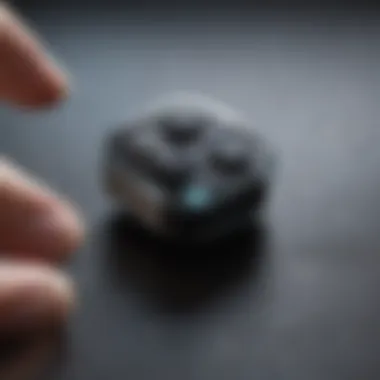Exploring EMDR Hand-Held Buzzers in Therapy


Intro
Understanding mental health is fundamental in today's fast-paced world. Individuals increasingly seek effective methods to manage their emotional well-being. EMDR therapy has gained attention for its approach to treatment. Especially, the instrument of hand-held buzzers offers a unique dimension to this therapeutic technique.
These small devices play a crucial role in an EMDR session. They are designed to facilitate bilateral stimulation by providing tactile sensations. This article aims to unpack the mechanisms behind hand-held buzzers and their use in therapy. Understanding these facets helps demystify how such tools can improve mental health.
Understanding Mental Health and Well-being
What is Mental Health?
Mental health refers to the state of our emotional, psychological, and social well-being. It affects how we think, feel, and behave in daily life. Good mental health contributes to the ability to enjoy life, cope with the challenges that arise, and interact positively with others. The World Health Organization emphasizes the interplay of mental health with physical health. A comprehensive view focuses not only on the absence of mental disorders but also on the effective functioning of individuals.
The Importance of Prioritizing Mental Well-being
Prioritizing mental well-being leads to numerous benefits. Individuals with good mental health are more productive and can maintain better relationships. This well-being allows for improved decision-making and reduces likelihood of having stress-related issues. Widespread stigma about mental health can often hinder individuals from seeking necessary support. Therefore, advocating for comprehensive mental health policies can foster a society that supports open discussions and treatment endeavors.
Common Mental Health Challenges and Disorders
Several factors can affect mental health. Common challenges include:
- Anxiety: Excessive fear or worry can overwhelm individuals, affecting day-to-day functioning.
- Depression: Feelings of sadness or loss of interest can persist and require professional intervention.
- Post-Traumatic Stress Disorder (PTSD): This typically follows a traumatic event and requires specialized treatments, such as EMDR.
Understanding these challenges is integral to providing the right support and selecting effective approaches for improvements.
Strategies for Improving Mental Health
Therapies and strategies for improving mental health are essential for growth and healing.
Self-care Techniques and Practices
Self-care practices play a critical role in mental wellness. Individuals can consider:
- Regular Exercise: Physical activity releases endorphins, improving mood and reducing anxiety.
- Healthy Eating: A balanced diet positively impacts not only physical health but emotional well-being too.
- Quality Sleep: Adequate sleep is vital for emotional regulation.
Building Resilience and Stress Management
Resilience is the ability to bounce back from difficulties. Techniques for building resilience include:
- Mindfulness: Promotes awareness of the present and has roots in many therapeutic practices, including EMDR.
- Problem-solving Skills: Developing skills to address problems head-on can reduce feelings of helplessness and dissatisfaction.
Effectively managing stress involves skills that help adapt to challenging situations without overwhelming oneself.
Seeking Professional Help: Therapy and Counseling
Therapeutic interventions are often necessary for deeper emotional struggles. Besides EMDR, options include:
- Cognitive Behavioral Therapy (CBT): Focused on changing negative cognitive patterns.
- Psychodynamic Therapy: Helps individuals explore subconscious influences on their behavior.
Finding Balance in Life
Creating balance in life supports mental wellness and prevents burnout.
Healthy Lifestyle Choices: Diet, Exercise, and Sleep
As previously discussed, a foundation of healthy choices supports emotional balance. A well-planned exercise regimen, combined with mindfulness practices like yoga, can significantly contribute to mental state clarity.
Mindfulness and Meditation Practices
Incorporating mindfulness exercises promotes emotional regulation. Mindfulness practices facilitate focus, and deep breathing aids in relaxation. Incorporating simple routines into daily life can lead to big improvements.
Setting Boundaries and Managing Time Effectively


Fine-tuning personal priorities ensures time for rest and leisure. Balancing commitments fosters a sense of fulfillment.
Tips for Maintaining Mental Well-being
Overall, taking proactive steps leads to tangible improvements in mental health.
Strategies for Preventing Burnout
Recognizing stress-inducing factors allows for timely intervention. Individuals should learn to say no when necessary, preserving energy for important life's aspects.
Coping with Challenges and Setbacks
Adapting a growth mindset is crucial. Each setback can be an opportunity for learning and improvement. Individuals can seek support from others during difficult times.
Creating a Supportive Environment
Strong social support can embody numerous formats, such as friendship or therapy groups. Feeling connected is essential for emotional well-being; fostering these relationships leads to stronger resilience.
The integration of EMDR therapy with hand-held buzzers is one of the emerging techniques that highlight the importance of using modern tools to facilitate effective mental health practices.
Prelims to EMDR Therapy
The introduction of Eye Movement Desensitization and Reprocessing (EMDR) therapy marks a significant advancement in the treatment of trauma. Understanding this method is vital for mental health professionals and individuals seeking effective therapies for PTSD and other trauma-related conditions. EMDR offers a structured approach to processing distressing memories. Within this framework, the use of EMDR hand-held buzzers emerges as a practical tool integral to the therapy's effectiveness.
Overview of EMDR
EMDR therapy centers around helping individuals process troubling memories through targeted interventions. It utilizes bilateral stimulation, which can manifest as controlled eye movements or auditory signals. More recently, therapy involving EMDR hand-held buzzers has gained prominence. These devices deliver tactile sensations alternately across the body. As simple as they are effective, buzzers support the bilateral stimulation needed for the reprocessing of traumatic memories. In essence, they enhance the therapy experience by offering an easy-to-manage adjunct that clients find helpful in many cases.
Understanding EMDR's core components is pivotal. EMDR is a multisensory therapy that allows traumatic memories to be processed at a comprehensive level. Clients can learn to manage their trauma and reduce the impact these memories have on daily life.
History and Development
EMDR therapy was developed in the late 1980s by Francine Shapiro. Shapiro's initial studies pointed out that eye movements could desensitize emotional disturbances linked to memories. This discovery sparked wider research and interest within the psychological community. Following continued research, EMDR became formally recognized as a valid treatment method for PTSD by organizations such as the American Psychological Association in the 1990s.
Since then, EMDR has evolved. The introduction of hand-held devices has become part of this evolution. Therapists noticed improved client engagement and satisfaction when incorporating these tools into EMDR protocols. The evolution reflects an ongoing trend in psychotherapeutic practices that leverage technology to enhance therapeutic outcomes. Today, it is crucial to understand not only the principles of EMDR but also how these hand-held buzzers fit into the larger practice of modern mental health care.
"Understanding the development of EMDR and the integration of tools like buzzers exemplifies the commitment to enhance therapeutic efficacy in trauma treatment."
The Function of Hand-Held Buzzers in EMDR
Hand-held buzzers play a crucial role in Eye Movement Desensitization and Reprocessing (EMDR) therapy. Their importance stems from the significant tools they provide for both therapists and clients. In this section, we explore how these buzzers function and the concept of bilateral stimulation, two elements foundational to effective trauma processing during EMDR sessions.
How Buzzers Work
In EMDR therapy, hand-held buzzers offer tactile sensations to facilitate bilateral stimulation. The devices are designed to deliver alternating touches to either hand. These rhythmic sensations resonate similar to the visual bilateral stimulation observed during eye movements.
Understanding how these buzzers work requires familiarity with two core concepts: sensory input and therapeutic objectives.
- Sensory Input: The buzzers activate through simple mechanisms. Users hold a buzzer in each hand. Upon activation, each device emits vibrations that travel through the hand to the wrist, creating engaging sensory experiences. This approach connects sensory processing to the traumatic memories being addressed, directing focus to both the emotional experience and sensation.
- Therapeutic Objectives: The use of buzzers aligns with centered objectives of EMDR. Enhanced emotional processing and desensitization concerning trauma become possible. These devices importantly serve people who may have difficulty articulating their thoughts, allowing the therapy to progress through streamlined physical stimuli.
As clinicians incorporate hand-held buzzers, it creates a synchronous environment for dialogue and processing in therapy textiles.
Bilateral Stimulation Explained
Bilateral stimulation is at the heart of EMDR's effectiveness. It seeks to access both hemispheres of the brain, moving information across via alternating symbolic routes. Buzzers fulfill this task seamlessly.
The process of bilateral stimulation can be summarized as follows:
- Right-Left Treatment Access: By alternating the buzz between both hands, buzzers ensure engagement with both sides of the brain. Right and left processing become crucial for emotional cross-communication during the therapy session.
- Cadence Recognition: The hesitancy often experienced during trauma can hinder emotional recovery. By using buzzers, clients can find a rhythm that mitigates anxiety and guides them gently through challenging topics. Gradually tackling trauma actively keeps fear in check as the session unfolds.
- Adaptive Activation: Buzzers are beneficial for assimilating thoughtful responses from clients impacted by adverse life events. Through activating areas of the brain responsible for soothing, buzzers help break negative serial thinking emerging from trauma.
“EMDR’s success hinges, in part, on these innovation tools enhancing therapeutic engagements and facilitating deeper processing.”
Benefits of Using EMDR Hand-Held Buzzers


The utilization of hand-held buzzers in EMDR therapy introduces distinct advantages that improve the therapeutic experience. These buzzers are more than simple devices; they serve to enhance the therapeutic process. Their presence can lead to amplified focus and engagement from clients, making them crucial to effective treatment. Furthermore, these instruments facilitate trauma processing, a core aim of EMDR. They also provide greater accessibility for a diverse range of clients seeking mental health support.
Enhanced Focus and Engagement
Hand-held buzzers are designed to capture and maintain the attention of clients during EMDR sessions. When well-integrated into the therapy, these electronic devices aid in truly focusing on the target memories. As the buzzers deliver alternating vibrations, clients are stimulated to engage cognitively and emotionally. This engagement is paramount for the efficacy of EMDR methodology.
Additionally, buzzers foster a structured rhythm that can mirror natural brain wave activity. This steady rhythm helps to reduce distractions over time, allowing clients to concentrate more intensively on their thoughts and feelings. The continual stimulation serves as a reminder of the physical aspects of EMDR, avoiding the disengagement that sometimes occurs in purely cognitive treatments.
Facilitating the Processing of Trauma
One of the primary advantages of using hand-held buzzers lies in their ability to support trauma processing. The principle of bilateral stimulation is fundamental in EMDR therapy. Hand-held buzzers provide a consistent and measurable form of bilateral stimulation. Unlike visual or auditory alternatives, the buzzer allows for tactile feedback, simplifying the therapeutic process for clients.
Research has shown that the physical sensation produces reassuring feedback. This feedback assists clients in cutting through intense emotional blocks often present when discussing traumatic events. As a result, clients can access difficult memories more safely and effectively. The buzzers smooth the transition from confronting past traumas to creating positive mental resources that support healing.
Greater Accessibility for Clients
Incorporating EMDR hand-held buzzers contributes to expanded access to therapy. For many clients facing anxiety or severe trauma, traditional therapy options may seem intimidating. Hand-held buzzers present a less daunting experience, helping to build rapport between the therapist and the client quickly.
Moreover, the accessibility may extend to varying client needs. Clients with disabilities or sensory processing disorders can find a personalized approach that works for them. This flexibility in materials minimizes discomfort and encourages engagement from previously hesitant clients. Consequently, this technology democratizes EMDR therapy, allowing individuals to seek help irrespective of their circumstances.
The use of EMDR hand-held buzzers manifests as an innovation in tackling mental health complexities, promoting deeper connection and effectiveness with clients experiencing diverse trauma responses.
The significance of benefiting from hand-held buzzers is perceived in numerous contexts, introducing tangible results in EMDR methodology, intrinsic to addressing mental health challenges today.
Practical Considerations for Therapists
When integrating EMDR hand-held buzzers into therapy sessions, therapists must thoughtfully consider various practical aspects. Careful selection and implementation of these devices directly impact therapeutic outcomes and client comfort. This section elucidates the essential elements to ponder in relation to using buzzers in EMDR therapy.
Selecting Suitable Buzzers
Choosing the right hand-held buzzers is critical. Different models may offer various features that can influence a therapy session. Some key factors to evaluate include:
- Ergonomics: Buzzers should be comfortable for clients to hold, promoting ease of use during therapy.
- Customizable Settings: Variations in speed and intensity can help tailor the experience for each individual client's needs.
- Durability: Reliable equipment is essential to avoid disruptions during the therapeutic process.
- Portability: Ease of transport allows for the flexibility to conduct sessions in different environments.
Additionally, therapists should recognize the significant role client feedback plays in the selection process. Engage clients in discussions about their experience and comfort level with specific devices. This feedback can guide further selections and adjust settings for optimal engagement.
Training and Implementation
The effective use of EMDR hand-held buzzers requires proper training. Therapists must familiarize themselves not only with the devices but also with how they fit into the EMDR protocol:
- Understanding Functionality: A hands-on experience with the equipment fosters better preparedness. This includes setting up the buzzers as well as troubleshooting issues during sessions.
- Integration into Protocol: Buzzers should complement the RMDR protocol without disrupting the process. Knowing when and how to use them effectively is essential for therapeutic engagement.
- Client Orientation: Educate clients about the buzzing sensations and their purpose in enhancing the effectiveness of the EMDR procedure. This minimizes anxiety related to technology use during therapy.
Training provides confidence, enabling therapists to use buzzers to their fullest potential for each client.
In summary, there are critical practical considerations when it comes to the use of EMDR hand-held buzzers. Selecting the right devices involves attention to detail, while solid training in their use ensures that therapists can maximize the benefits for clients. Balancing technology with the formation of therapeutic rapport creates an environment conducive to healing, making these practical considerations vital for effective therapy.
Scientific Research and Evidence-Based Support
The role of scientific research in the realm of EMDR (Eye Movement Desensitization and Reprocessing) therapy cannot be overstated. An evidence-based foundation lends credibility to therapeutic approaches and enhances the overall trust in the methods utilized by mental health professionals. By analyzing empirical data, we can better understand how hand-held buzzers function within this therapy and affirm their contributions to trauma processing.
Clinical Studies on EMDR Effectiveness
Much of the support for EMDR practices originates from clinical studies verifying its effectiveness for different populations experiencing trauma and related diagnoses. Notable meta-analyses have shown EMDR can lead to significant reductions in symptoms of PTSD in adults and adolescents alike.
For instance, studies have indicated that many individuals report decreased levels of distress after just one session. Further longitudinal studies provide evidence that the benefits of EMDR persist long after treatment is concluded.
It is significant to note that multiple outcomes associated with EMDR suggest broader implications for mental health. The research typically highlights key elements such as:
- Rapid reductions in traumatic memories given the usage of the hand-held buzzers.
- Improvement in associated symptoms such as anxiety and depression.
- Decreased avoidance behaviors and enhanced emotional regulation.
These findings illustrate that EMDR is not simply effective for symptom reduction; rather, it contributes to transformation in the overall quality of life.


Research on the Use of Hand-Held Devices
Another important aspect of scientific inquiry addresses the specific application of hand-held buzzers during EMDR sessions. Various studies assess feedback from therapists and clients regarding their use, particularly looking at factors like effectiveness, user experience, and overall satisfaction.
Key considerations from current research include:
- User Comfort: Research indicates that patients often prefer hand-held buzzers over visual or auditory cues, which allows them to focus attention where needed, particularly during intense recall sessions.
- Consistency in Stimulation: Controlled studies have demonstrated that the bilateral stimulation provided by hand-held devices tends to offer a more uniform experience compared to other methods. This consistency helps participants to process traumatic memories more effectively.
- Client Autonomy: Hand-held devices bolster a sense of empowerment for clients, letting them control the pace and volume of the stimulation if they desire. This control reinforces their engagement in the therapeutic process.
In summary, continuing to examine the interplay between EMDR therapy and the use of hand-held buzzers establishes core conclusions that affirm their role in fostering an effective therapeutic environment. The mounting body of evidence reflects not only the efficacy of EMDR but also the valuable contributions that hand-held devices make to improving mental health outcomes.
Limitations and Challenges
The discussion around EMDR therapy is incomplete without addressing the limitations and challenges associated with the use of hand-held buzzers. Being aware of these potential hurdles is crucial for therapists and clients alike. Understanding these factors can lead to a more informed application of this therapy, ensuring the best possible outcomes in trauma recovery.
Potential Issues with Equipment
Hand-held buzzers, while effective, come with certain challenges. The reliability of the devices is a primary concern. Technical malfunctions can disrupt sessions, hindering the therapeutic process. This underlines the imporatnce of selecting high-quality device brands that are well-reviewed in the field of EMDR therapy.
Factors to consider may include:
- Battery Life: Frequent battery replacements or low charge can interrupt sessions unexpectedly.
- Sensitivity and Settings: If not calibrated or chosen according to the client's needs, these buzzers might not provide optimal stimulation. Different individuals may require different intensities based on personal comfort.
- Cost: For some therapists or clinics, financial constraints may make it difficult to invest in state-of-the-art equipment. Thes is especially signficant in diverse therapy settings where budgets are tight.
Bearing these potential issues in mind, practitioners can take proactive measures. Regularly testing equipment, setting up a maintenance schedule, and ensuring the necessary spare parts or replacements are available would mitigate some technical difficulties.
Client-Specific Considerations
Each client’s experience with EMDR therapy varies, and understanding individual specific challenges is essential for successful treatment. Factors may include.
- Previous Experiences with Technology in Therapy: A client’s background in using similar tools can influence their familiarity and comfort. New clients might feel apprehensive about adopting technology during therapy sessions, leading to withdrawal or resistance.
- Sensitivity to Sensory Input: Hand-held buzzers engage the sense of touch heavily. For clients who are sensitive to sensory stimulation, this can provoke anxiety or discomfort during EMDR sessions.
- Cultural Considerations: Different cultures may view the use of technology during therapy differently. This might include varying beliefs about what constitutes an effective therapeutic agent. However, good communicator of how these devices function, their benefits and their place within the therapeutic framework can alleviate resistance.
These factors amplify the necessity for therapists to communicate openly with their clients. Gathering intel about any preferences, past involvements, or concerns associated with utilising buzzers can significantly enhance therapeutic effectiveness.
By acknowledging these limitations and challenges, therapists can foster a more supportive environment that can potentially downplay any adversity related to EMDR practices. A careful consideration of both medical equipment and client characteristics will constitute a more effective, nuanced application of therapy. Through rigorous attention to these challenges, EMDR therapy can time and again serve its purpose.
In summary, awareness of equipment limitations and client-specific considerations is crucial. Such recognition heightens the practitioner's capability to adapt and refine their approach, ultimately benefiting the therapy process.
Future Directions in EMDR Therapy
The evolution of EMDR therapy is an ongoing process, characterized by new techniques, tools, and research findings. The future directions in EMDR therapy suggest potential advancements that can optimize treatment efficacy. Emphasizing these advances, clinicians and researchers alike are shaping the way EMDR is practiced. Understanding these trajectories is fundamental not just for therapists but also for clients seeking effective mental health interventions.
Technological Advancements
Technological advancements in EMDR therapy are indeed pertinent. With the advent of software and hardware looking to simplify and enhance the practitioner’s workflow, multiple options have arisen. For instance, newer hand-held buzzers come equipped with features that allow customization of stimulation patterns, ensuring that therapists can tailor the experience to individual client needs. Furthermore, digital platforms can offer videoconferencing options that maintain therapeutic effectiveness, bridging geographic gaps for many who seek help. In addition, app-based tools may soon allow clients to engage in self-guided adaptations of the EMDR process, providing them greater control over their healing journey.
While technology augments the effectiveness of the therapy, it brings along fresh considerations. Issues like ensuring security of client data and maintaining the integrity of therapeutic settings must be addressed. Instructing users on the emerging equipment ensures both gives maximal value during sessions without compromising client experience.
Integration with Other Therapeutic Modalities
Another significant direction is the integration of EMDR with other therapeutic modalities. Combining EMDR with cognitive-behavioral therapy (CBT) can provide a holistic approach to treatment. For example, exploring cognitive distortions while concurrently employing EMDR may fast-track the resolution of distressing material. Furthermore, integrating mindfulness practices into EMDR sessions may help clients cultivate a greater awareness, aiding their processing journey.
A multidisciplinary approach allows for flexibility, with therapists able to adapt methods based on each client’s unique circumstances. Synchronous use of other modalities can enhance the overall effectiveness and broadens the horizon of creative approaches in therapy.
“The future of EMDR therapy lies not simply in its isolated application or the advancements of hand-held buzzers, but in how seamlessly it can integrate with various treatment frameworks to provide comprehensive mental health assistance.”
End
The conclusion serves as a vital component of any comprehensive examination of EMDR therapy's techniques, specifically regarding the role of hand-held buzzers. These devices are more than mere instruments; they significantly enhance therapeutic interventions for clients dealing with trauma. By emphasizing the importance of these tools, one can appreciate how they facilitate the therapeutic process effectively.
Summary of EMDR Buzzers' Role in Therapy
In summary, EMDR buzzers play an essential role in assisting clients through trauma processing. Their use supports bilateral stimulation, which is crucial for enhancing the effects of eye movement techniques. They can improve focus and engagement while promoting a profound connection between mind and body.
The benefits of employing these buzzers are manifold:
- Improved engagement: Clients often find they are more present and focused during sessions when hand-held buzzers are utilized.
- Facilitating trauma processing: The buzzers can help desensitize the emotional response attached to specific memories, allowing clients to process their trauma more effectively.
- Accessibility: Buzzers provide a unique advantage as they can also be used in various settings. This benefits clients who may experience limitations in travel or availability during standard therapy sessions.
Ultimately, the integration of EMDR hand-held buzzers into therapy not only enhances the effectiveness of the treatment but also supports clinicians in achieving optimal client outcomes.
As the field evolves, understanding the application of these tools becomes crucial for those prioritizing mental health and wellness. Cognitive strategies combined with physiological responses create a synergistic effect, enabling deeper healing processes. Clinicians and individuals alike should acknowledge the implications and possibilities that EMDR hand-held buzzers introduce into therapeutic environments.















